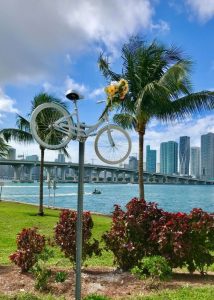On August 22, 2020 Marcio Cemin was taking a short bike ride on Key Biscayne when he tried to make a u-turn on Crandon Boulevard near Crandon Park. A van that was approaching slammed on its brakes and Marcio hit its rear end. Next thing he knew, he was on the ground with cuts on his arms, hands and knees as well as bruises on his ribs. He also hit his head.
“Now I have to be more attentive because the drivers are not,” he said. “I’m the one that needs to be paying attention because their heads are not out there paying attention to the cyclists,” said Cemin.
Cemin sued and his case was settled for an undisclosed amount.
Bicycling can indeed be dangerous in South Florida. Over 58 people have been killed on bicycles in the region in the last three years alone. Florida is regularly rated the nation’s most dangerous state for cyclists.
Accidents occur to people of all ages and backgrounds, and being a skilled rider doesn’t seem to protect victims of cycling accidents.
“I think if you get down to it, a root cause of all the accidents would have to be distraction and distracted drivers,” says John Sabatier, president of the Everglades Bike Club.
Adds club vice president Sue Kawalerski, “There are many reasons that cycling accidents happen. One of the biggest is distraction on the part of drivers, cyclists and pedestrians.”
The following stories showcase the varied nature and unpredictability of cycling accidents. The people involved are of different ages and the situations vary.
- Fred Medina was a 58-year-old network executive for BBC Worldwide, HBO and A+E. On March 17, 2021 he went out for a ride and came to the South Miami Avenue bridge on the Miami River at around 6 a.m. The bridge was coming up but Medina still attempted to cross. As it rose, he hung onto the railing, but then he slipped and fell. Police arrived a few minutes later and found him dead.
- Sunny LaValle was riding her bike on Bonaventure Boulevard in Weston at 8 a.m. on May 23 when a driver, Oion Syvell Johnson, struck her from behind, killing her. Tire tracks left behind show that Johnson was driving on the grass for some time before swerving back on the road. More than 40,000 people have signed a petition demanding further investigation.
- A 15-year-old boy was riding his bike in Pembroke Pines on May 10 when he attempted to cross the Westford Plaza entrance just after 5:30 p.m. At the same time a motorist, Joan Ferris, was making a right turn out of the plaza and struck the teen. The boy was then dragged for 30 feet by the car before it made a complete stop. First responders had to lift the car to extract the minor’s body from beneath it.
How to reduce such incidents?

Some strides have been made in the past. In 2014, Harry Gottlieb, a cycling activist, noticed that cyclists were continuously getting hurt on bridges because metal grates become slippery when wet. Gottlieb lobbied Miami-Dade County and the Florida Department of Transportation to install dedicated non-slip bikes lanes on several bridges in Miami. Within the last six years, non-slip bike lanes have been installed on bridges across the county.
“I’ve been told that when people find out I had something to do with it they call out my name as they cross the bridge, like as a thank you for making cycling a little safer,” Gottlieb says.
Bike lanes have been added in many parts of South Florida, but the region remains dangerous.
Cycling groups and organizations have thought of other ways to bring awareness to the issue such as the Ride of Silence, an annual 16-mile trek that honors those who have passed due to cycling accidents and to support others that have been injured in them.
Personal injury attorney and cyclist Lee Marks says that in order truly decrease the number of accidents, there needs be a connection between cyclists and motorists, speed limits must be lowered and more dedicated bike lanes need to be built in areas like Biscayne and Coral Gables.
“We need to build on the culture that bikes and cars can mix,” Marks says, “We can respect each other.”

































